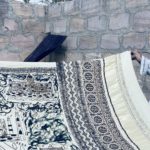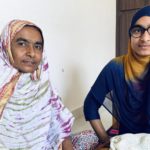Ajrakh’s web of connections
The Khatri family is legendary across Kutch. They are craftsmen who are involved with all of the decorative arts including Ajrakh and Bandhini.
Ajrakh today is kept alive through a complex web of familial connections involving cousins and uncles, all of whom lead independent yet interdependent lives. It began with the late great Khatri Mohammed Siddiqui, who used natural dyes to create Ajrakh fabric for the herders, shepherds, and other pastoral communities of Kutch. He had three sons: Abdulrazzak, Ismail and Abduljabbar. These three sons are the ninth generation of Khatri printers and dyers.
An oft quoted legend about the Khatri family is that they came to Kutch from Sindh some 400 years ago at the invitation of the King Rao Bharmalji who ruled the district in the 16th century. Here is an excerpt taken from Abduljabbar’s family archives. It in, the late Mohammad Siddiqui talks about their history.
“The Rao gave us gifts of land and we were free to choose where we wanted to build our homes. We also paid no tax. My family belongs to the Dhadha sub caste and my ancestor, Jindha Jiva, chose the site of the Dhamadka because the river Saran runs through it. A good supply of running water is necessary for different stages of dying and washing cloth. Our customers included the royal court and the Maldhari herders of Kutch.”
A lot is known about Dr. Ismail Khatri. But his brother, Abduljabbar (and his sons including Adam who is featured here) are evolving Ajrakh in interesting new ways. One way that they are giving Ajrakh a fresh new look is by creating miniatures or reducing the size of the print. As you see in the below video.
Why did they convert to Islam?
The Khatris came to Kutch as Hindus but converted to Islam in the 17th century. As Hindus, they were obliged to make exorbitant payments and give expensive gifts to the Bhatts: genealogists who recorded all the births, marriages, and deaths for the caste.
In the end, the gifts became so onerous that the Khatris could not afford them. They were confronted by a dilemma. If they didn’t pay, the names of their sons and daughters would not be recorded in the books of the family lineage which was a sign of legitimacy. Arranging marriages would then become impossible. How to prevent giving such expensive gifts to the geneologists/Bhatts? The solution came in the form of Sufism.
At that time, there were Sufi saints in Kutch who explained the tenets of Islam to local people. To the Khatris, the simplicity of the faith and the lack of financial burdens persuaded them to accept Islam and they converted in large numbers.





